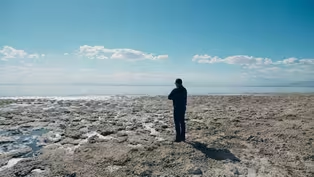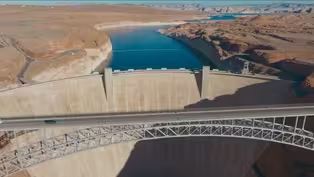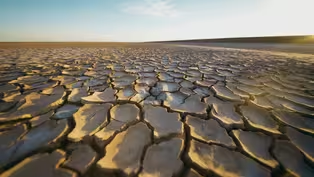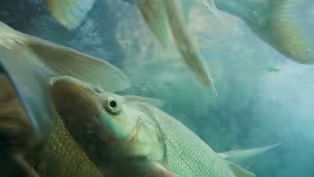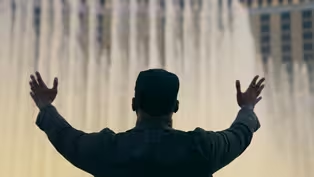
The Dam Truth: What Glen Canyon Tells Us About a Drying West
Clip: Season 2 Episode 5 | 9mVideo has Closed Captions
The Glen Canyon Dam promised water and power — but the river had other plans.
The Glen Canyon Dam once symbolized American engineering might. But the Colorado River it was built to tame is shrinking. Shane meets dam managers, river advocates, and tribal leaders to explore the legacy — and limitations — of the West’s water megaprojects. Can a 20th-century marvel survive the realities of a 21st-century climate?
Problems playing video? | Closed Captioning Feedback
Problems playing video? | Closed Captioning Feedback

The Dam Truth: What Glen Canyon Tells Us About a Drying West
Clip: Season 2 Episode 5 | 9mVideo has Closed Captions
The Glen Canyon Dam once symbolized American engineering might. But the Colorado River it was built to tame is shrinking. Shane meets dam managers, river advocates, and tribal leaders to explore the legacy — and limitations — of the West’s water megaprojects. Can a 20th-century marvel survive the realities of a 21st-century climate?
Problems playing video? | Closed Captioning Feedback
How to Watch Human Footprint
Human Footprint is available to stream on pbs.org and the free PBS App, available on iPhone, Apple TV, Android TV, Android smartphones, Amazon Fire TV, Amazon Fire Tablet, Roku, Samsung Smart TV, and Vizio.
Buy Now

Surprising Moments from Human Footprint
Do you think you know what it means to be human? In Human Footprint, Biologist Shane Campbell-Staton asks us all to think again. As he discovers, the story of our impact on the world around us is more complicated — and much more surprising — than you might realize.Providing Support for PBS.org
Learn Moreabout PBS online sponsorship(soft music) (Shane) Our technological overhaul of the Colorado River... (water lapping) ...began more than a century ago... (whooshing) ...as the U.S. was trying to populate the West... (whooshing) ...while transforming itself into a new kind of superpower.
(train bell clanging) The river was a key to both goals.
♪ (whooshing) You ever get tired of seeing this?
(Gus) No, I’ve worked in industrial places -most of my life.
-Yeah.
(Gus) Nothing as visual as this.
I mean, it’s pretty incredible.
(hip-hop music) ♪ (elevator bell chimes) (Shane) Gus Levy used to be a mechanic in the Navy.
He worked on ships, submarines, nuclear power plants, and eventually dams.
♪ So, you really like fixing humongous things is basically what it is.
(Gus) Yeah.
Yeah.
Yeah.
(Shane chuckles) ♪ (Shane) Today, Gus manages the Glen Canyon Dam, a 710-foot-tall concrete giant in northern Arizona.
(soft music) The inspiration for the Glen Canyon Dam was its downstream predecessor, the Hoover Dam.
(hip-hop music) The tallest in the world when it was built in 1935, Hoover was conceived to bring water and hydroelectric power to people across the Southwest.
♪ And the world took notice.
♪ The Hoover Dam ushered in a global age of mega-dams, which continue to transform the world’s rivers... ♪ ...including here at Glen Canyon, a few hundred miles upstream of the dam where it all began.
♪ (Gus) So, I think they poured from 1960 to 1963 around the clock.
(Shane) Wait a minute.
From ’60 to ’63, they poured concrete constantly?
Yes.
Yes.
(soft music) (Shane) Like the Hoover Dam, the Glen Canyon Dam is a marvel of engineering.
♪ But the water it was designed to capture has been...unreliable.
(Gus) It’s been drier and warmer than it has been in the recent past.
(Gus chuckles) We have a reservoir, which is like a bank savings account for, you know, drier times.
But the other thing is this place makes power, -right?
-Yeah.
(Gus) The revenues from that power pay for all the operations and maintenance here.
(soft, tense music) That’s where that concrete batch plant was, and those rails are under the water there.
Last year in the spring, they were exposed.
(Shane) Okay.
I’m assuming that’s bad news.
(Gus) Uh, yeah, it’s pretty distressing to see it that low, because they got down just a little bit under the elevation of 3,520.
This place was not designed to run below 3,490.
♪ (Shane) The shallower the reservoir, the less pressure there is to turn the dam’s massive turbines.
In April 2023, the Glen Canyon Dam’s reservoir, also known as Lake Powell, dropped to a level just 30 feet above the minimum required to generate electricity.
♪ (water flowing) The dam was designed for a version of the Colorado River that no longer exists... and maybe never did.
(mellow music) In 1922, seven southwestern states negotiated an agreement, now called the Colorado River Compact, that allocates the river’s water among the states.
But despite warnings from scientists, the Compact commits an exact amount of water to each state rather than a percentage of what actually exists.
And these numbers are based on a series of unusually wet years in the early 1900s.
So, the Compact often promises more water than today’s river can possibly provide.
(water trickling) (whooshing) Lake Powell, first filled in 1980, reached its peak in 1983, and has been dwindling ever since.
Made possible by viewers like you!
(speaking echoes) Human Footprint!
(speaking echoes) -What up?
-Hey, welcome to Echo Cove.
(mellow music) (Shane) Rob Callaway runs a boat rental and guide business out of Page, Arizona.
♪ A town founded in 1957 to help build the dam.
♪ It was pretty quiet when I was there in November, but in the summer, Lake Powell is...a scene.
(energetic music) ♪ Lake Powell may be a one-of-a-kind hotspot for outdoor recreation, but the canyon walls reveal a harsh reality of this increasingly arid landscape.
(soft, solemn music) (Rob) Here, this is a bathtub ring, as some people refer to it.
And that’s really a good indication of lake levels when the lake is full.
(Shane) Whoa.
♪ So, this is like a big farmer’s tan is what I’m looking at, basically.
Absolutely.
(Shane) Today, the bathtub ring is more than a hundred feet above the reservoir’s surface.
♪ Even as it dwindles, Lake Powell is a striking, surreal place.
There’s really nothing quite like it.
But for many, there was also nothing like the Glen Canyon... (whooshing) ...the natural wonder that the dam drowned under Lake Powell.
(projector clicking) (guitar music) Tribes and environmental groups protested the dam, knowing the cultural and ecological treasures that would disappear under hundreds of feet of water.
(phone ringing) (whooshing) (Tahlia) My grandfather lived in Tuba City, and when the desert got really hot, we would drive up to Page to Antelope Point in Lake Powell.
(mellow music) (Shane) Tahlia Bear works with a coalition of tribes advocating for water policy reform.
When she isn’t hard at work, she loves getting to know her new home in Colorado and reconnecting with her childhood stomping grounds.
♪ (Tahlia) Since time immemorial, 30 federally recognized tribes have called the Colorado River Basin home.
But the environmental concerns or the reliance of the river by the tribes in the basin has not been considered in a lot of the decision-making.
(solemn music) (Shane) When the Colorado River Compact was signed in 1922, Native voices weren’t included in the process.
And today, even though some tribes have a legal right to Colorado River water, many don’t have the complex and expensive infrastructure to bring water where it’s actually needed.
(Tahlia) The Navajo nation is just a little bit larger than the state of West Virginia.
And 30% of households do not have running water.
♪ (Shane) In your mind, like, having a seat at the table, should that be the ultimate goal, or should we be thinking about this entire thing differently?
(Tahlia) What I would say is that, overall, the Colorado River needs to be managed as a living whole system rather than a plumbing system.
Mm.
(Tahlia) And if we all want to provide water as a human right, we need to change the management of it.
(whooshing) (Shane) The mega-dams pioneered in the American West were a triumph of human ingenuity, a milestone in our quest to control water.
(mellow music) But they turned a living river into an engineering problem.
And today, that river’s rhythm is dictated not by nature but by our ever-changing demands for water and power.
♪ Below the Glen Canyon Dam, the Colorado River flows through one of the planet’s most extraordinary landscapes.
♪ The Grand Canyon, of course, isn’t underwater.
But it’s been reshaped by this dam nonetheless.
♪ To understand how and to exercise our God-like control of the river to benefit both humans and ecosystems, we need solid data to guide our decisions.
♪
The Beach Boys Played Here. Now It’s a Toxic Dust Bowl.
Video has Closed Captions
Clip: S2 Ep5 | 5m 13s | Toxic dust, dead fish, and vanishing water — what happened to California’s inland sea? (5m 13s)
Video has Closed Captions
Preview: S2 Ep5 | 30s | A journey down the Colorado River reveals the ripple effects of humanity’s quest to conquer water. (30s)
Reviving the River: Hope Returns to the Colorado Delta
Video has Closed Captions
Clip: S2 Ep5 | 4m 59s | Aída Navarro joins the fight to revive the Colorado River Delta — and hope is flowing again. (4m 59s)
Tag, You're It: Tracking the Grand Canyon's Toughest Fish
Video has Closed Captions
Clip: S2 Ep5 | 4m 35s | USGS biologists tag humpback chub to monitor life in a changing Grand Canyon river. (4m 35s)
Vegas vs. the Desert: Plumbing the Impossible
Video has Closed Captions
Clip: S2 Ep5 | 11m 19s | Las Vegas defies the desert with epic engineering — but at what long-term cost? (11m 19s)
Providing Support for PBS.org
Learn Moreabout PBS online sponsorship
- Science and Nature

Explore scientific discoveries on television's most acclaimed science documentary series.

- Science and Nature

Capturing the splendor of the natural world, from the African plains to the Antarctic ice.












Support for PBS provided by:
